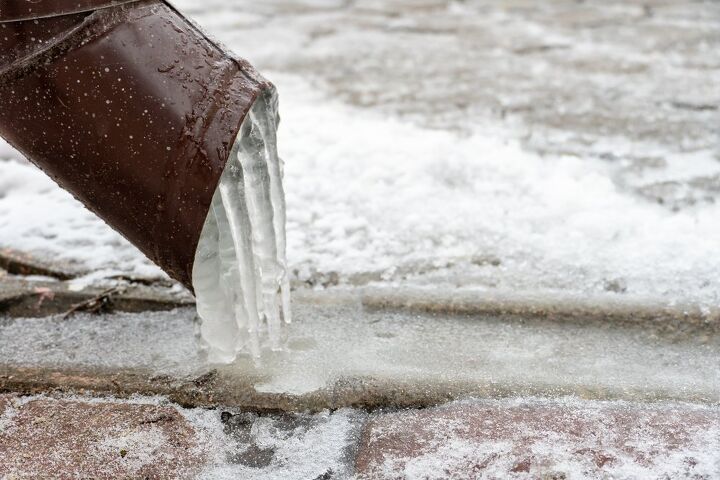How To Run A Downspout Under A Sidewalk (Do This!)

Installing a proper residential drainage system can be a complicated task. It’s incredibly labor-intensive and nearly each project can present its own unique set of challenges – like needing to run a downspout under a sidewalk. This specific setback isn’t generally one that homeowners consider until it becomes absolutely necessary.
While you could always lay down on the ground and dig a hole beneath the sidewalk by hand, this is uncomfortable and very time-consuming. Instead, you can use either a piece of PVC cut at an angle and a sledgehammer or water pressure to successfully run a downspout under a sidewalk.
Whether your goal is to install a pop-up emitter on your curb or extend a downspout under pavers into your lawn, we’ll walk you through all the essential steps to run a drain pipe underneath a sidewalk or walkway.
Do You Need Gutter Installation Services?
Get free, zero-commitment quotes from pro contractors near you.

What is a Downspout?
A downspout is a lightweight piece of tubing which extends out vertically from your gutter to the ground. Its primary purpose is to direct excess rainwater away from your home by a controlled means. Virtually all gutter systems operate the same way, where gravity directs rainwater through a sloped gutter channel to the downspout and then away from your property.
Downspouts are an essential part of any gutter system, as it helps to prevent damage to your home’s foundation and erosion of the soil on your property. After all, a properly functioning drainage system is vital to avoiding moisture, corrosion, and protecting your basement from flooding during storms.
Initial Considerations
There are a number of do-it-yourself methods to dig a hole underneath a section of the sidewalk. While it can be a challenging task, the level of difficulty is dependent on your soil type and makeup. For instance, clay soil and rocky soil will be much harder to bore your way through. Clay soil consists of very fine mineral materials and very little organic material. Since there is not much space between the particles, it does not drain well and can be displeasure to work with.
Another factor to consider prior to beginning the project is the standard thickness of sidewalks. Most conventional sidewalk slabs are four inches thick with another several inches of gravel underneath. If you’re working with pavers or stamped concrete, the thickness will be roughly the same. Make sure that you keep this in mind when you’re digging both the initial hole and the trench.
How to Run Downspout Under Sidewalk
The standard procedure for installing a drainage pipe is relatively straightforward. As far as materials go, you’ll need the pipe itself, PVC elbows, couplings, T-fittings, adapters, and various other specialty fittings to allow you to connect the pipe sections together. You’ll also want to acquire some PVC primer and cement for adhering the parts.
Installing a drainage pipe is generally done in three phases: digging the trench, laying out the pipe, and backfilling with soil. When you need to run the downspout underneath a sidewalk, the only thing that differs is the method with which you dig the hole under the cement.
Step One: Prep and Mark the Trench
Before you begin with running the downspout underneath your sidewalk, you first want to plan out the trench. Using a string and 1×2 wood stakes, you’ll first want to plan out where the trench will go. Install the stakes in front of each downspout. Then, sprinkle flour along the string to mark the trench line.
Quick Tip: To help make backfilling go more efficiently, remove the string and position cardboard along the edge of the white flour line.
Step Two: Dig the Trench
With the trench marked, you can start digging it out and depositing the dirt onto the cardboard. When it comes time to backfill, this will make the process go much smoother. The trench should slope down slightly (one to two inches per length of pipe) to allow for water to drain away from the downspout. It should also be at least six inches wide and ten inches deep.
Again, sidewalks are typically about four inches thick with a few additional inches of gravel. Keep this in mind when you’re digging the trench on either side of the sidewalk. The level of difficulty to hand dig the trench with a shovel will depend on the length of the trench and the type of soil. As an easier alternative, you may consider using a trenching machine or hiring a backhoe operator.
Quick Tip: In exceptionally cold areas, the downspout can clog with ice, on occasion, during instances of heavy precipitation. This most often happens when the temperature during the day is mild but then drops below freezing at night. The only foolproof way to keep the pipe from freezing is to bury it below the frost line, or between 32 and 48 inches in most regions of the snowbelt. However, digging a trench that deep is only sensible when the pipe is connected to an existing drain line or drains into a dry well.
Step Three: Running the Downspout Under the Sidewalk
With the length of your trench built, along with trenches on either side of the sidewalk, you can move on to digging the hole under the sidewalk. For this, you have the choice between two methods:
- Dry PVC pipe needle – The first method involves cutting one end of a PVC pipe at roughly a 45-degree angle. Then, using a sledgehammer or mallet and a block of wood, drive the chiseled end of the PVC pipe to cut through the soil underneath the sidewalk. Repeat this process until the pipe comes out the other side of the sidewalk. Although labor-intensive, this method is effective.
- PVC pipe and water pressure – The second method makes use of water pressure to shove the pipe through the dirt and under the sidewalk. This can be easily accomplished with a simple garden hose. However, for best results, use a pressure washer. Regardless, you’ll need to acquire an adapter set to connect the PVC pipe to the hose. With this method, make sure that you wear eye protection, as the water is very powerful. Depending on the type of soil in your yard, this option will likely be faster than just using the PVC pipe to carve out a hole.
Make sure that you perform this step about a foot below the walkway to prevent any cracking from occurring in the future. Regardless of the method that you choose, digging a hole to run a downspout under a sidewalk doesn’t have to be especially challenging.
If you need a larger tunnel underneath your sidewalk, such as a 4-inch drain line, the procedure will differ slightly. Drill the initial hole first using water pressure and a 1-inch PVC pipe. Then, use a larger diameter piece of PVC to push and wiggle in place, following the smaller hole that was drilled by the water. Although this may take some extra effort, the ground should be softened up from the water.
Step Four: Finish Up and Backfill
With the downspout successfully installed underneath your sidewalk, all that’s left is to finish up the job of installing the entire drainage pipe. At the end of your trench, dig a shallow, wide hole and line it with flat rocks or a 4-inch layer of gravel. Then, rest the end of the pipe on this rocky surface and cover it with more rocks.
If you placed wide pieces of cardboard alongside your trench, the backfill process should be a breeze. Simply use a garden hoe to pull dirt off of the pieces of cardboard to fill the trenches.
Do You Need Gutter Installation Services?
Get free, zero-commitment quotes from pro contractors near you.

Related Questions
How deep should a drainage pipe be buried?
The average drainage ditch is six inches wide and 12 to 18 inches deep. It is most effective to place a drainage pipe in a trench with a depth of 12 to 18 inches and then fill the hole with gravel. This allows for adequate water flow.
Due to their versatility and availability, plastic pipes are the preferred type for underground drainage. They are also easy to install, lightweight, and come in a variety of diameters to accommodate different amounts of water.
Related Guide

Jessica considers herself a home improvement and design enthusiast. She grew up surrounded by constant home improvement projects and owes most of what she knows to helping her dad renovate her childhood home. Being a Los Angeles resident, Jessica spends a lot of her time looking for her next DIY project and sharing her love for home design.
More by Jessica Stone












![10 Best Electric Lawn Mowers - [2022 Reviews & Top Rated Models]](https://cdn-fastly.upgradedhome.com/media/2023/07/31/9070486/10-best-electric-lawn-mowers-2022-reviews-top-rated-models.jpg?size=350x220)


![12 Washing Machine Brands to Avoid [with Recall Data]](https://cdn-fastly.upgradedhome.com/media/2023/07/31/9075781/12-washing-machine-brands-to-avoid-with-recall-data.jpg?size=350x220)











